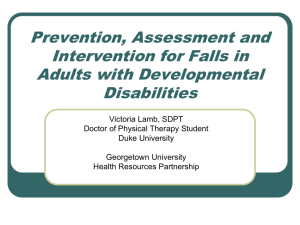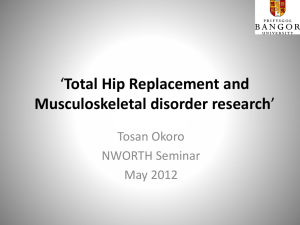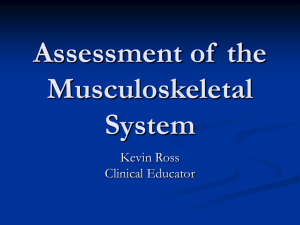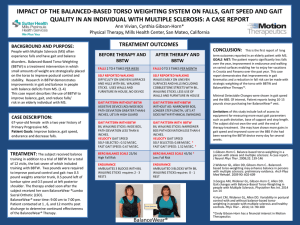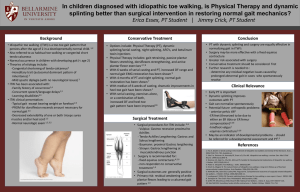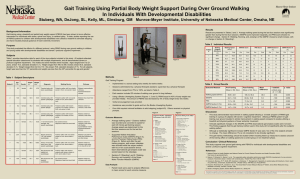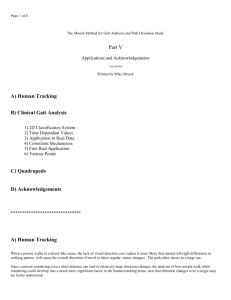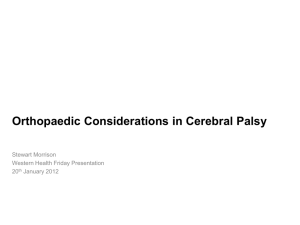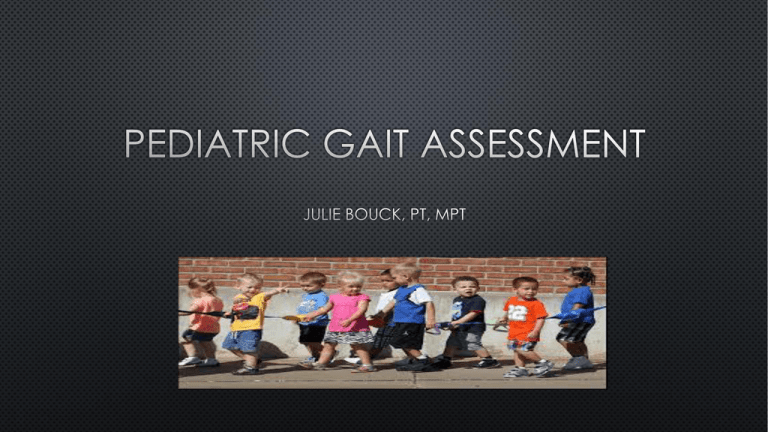
•
•
•
•
•
•
•
•
•
•
THREE ROCKERS
HEEL ROCKER.
Lasts from initial contact to the time of foot flat. Its
function is to translate the vertical component of the
ground reaction force into forward progression of the
tibia through the link provided by the eccentric
action of tibialis anterior.
ANKLE ROCKER.
Lasts from the time of foot flat to heel rise. Its function
is to control the rate of forward progression of the
body as the tibia rotates at the ankle joint over the
fixed foot under the eccentric control of the triceps
surae.
FOREFOOT ROCKER.
Lasts from heel rise until the end of stance. It
functions to extend the period of ground contact via
the gastrocnemius to exploit the GRF vector’s helpful
influence on swing initiation.
What is the best way to
measure gait?
“Whilst instrumented gait assessment that
provides quantitative measures of threedimensional gait kinematics and kinetics and
the electrical activity of muscles remains the
gold standard for gait assessment, in the
context of routine clinical practice it is still
restricted by the fact that it is laboratory
based, expensive, and requires a high-level of
interpretation skills “(Messenger and Bowker,
1987; Davis, 1997; Geurts et al, 1990; Morton,
1999; Coutts, 1999).
• Simple cost effective, and quick tests that we can deliver to make
clinical decisions.
• Within the rehab and school environment, the time available for
functional assessment is often limited to 45 to 60 minutes a session.
• Standardized test that have been shown to be valid and reliable
instruments.
• Williams et al,(2005):
• TUG is reliable in children as young as 3 years of age
(176 Children without disability/ 41 with CP or Spina
bifida)
• Mean TUG score for children w/o disability 5.9s
• Preschool children took 6.7 s
• Spastic Hemiplegia 8.4s (n=4)
• Spastic Diplegia 10.1 s (n=22)
• Spastic quadriplegia 28 s (n=6)
• Spina bifida with low level lesion 8s (n=7)
• It integrates transitions and walking skills/responsive to
change
• It is a useful benchmark to establish baseline levels of
functional mobility
Timed up and Go Cont
• Dunaway et al (2014)
• 15 ambulatory Spinal Muscular Atrophy (SMA)
patients (10-49 years old)
• TUG scores correlate with clinical, functional, and
strength assessment and decline linearly over time.
• Tug was associated significantly with total leg and
knee flexor strength and 6 minute walk test.
• High test re-test reliability
• D’Agostini et al (2014) TUG norms and TUG Down syndrome
• Tested school age children from ages 3-18 (n=459)
• Tested children with down syndrome ages 3-18 (n=40)
• Normative population data for the TUG
• TUG values can be predicted as a function of age and weight.
• TUG(s) = 6.387-(age(y) x 0.166) + (weight (Kg) X 0.014).
• GMFM correlates with the TUG test in children and adolescents with
down syndrome
SIX MINUTE WALK TEST
The six minute walk test is the distance a person
can walk at a constant, uninterrupted, unhurried
pace in 6 minutes
•
Lammers et al (2008)
• 328 healthy children ages 4-11
• Distance walked increases with age.
• Requires submaximal effort in healthy
children
•
Ulrich et al (2013)
• Depends mainly on age
• Heart rate after 6MWT, height and weight
add information
• May help to better assess and compare
outcomes in patients with cardiovasulcar
and respiratory disease.
The walking course must be 30 m in length (100 ft hallway required). Turn around
points should be marked with a cone. A line at the beginning and end should be
marked with bright tape.
Instructions to the Patient
*Note: Instructions must be consistent.
(Put the instructions on a laminated card and read them out loud to the patient.)
- Describe the walking track or area to the patient.
- Explain the objective of the test.
- Provide instructions on what to do and what not to do during the test.
- Emphasize reporting any untoward effects.
- Sample instructions:
“You are now going to do a six-minute walking test. The object of this test is to walk
as quickly as you can for six minutes around the track (or up and down the corridor
etc… depending on your track set up) so that you cover as much ground as possible.
You may slow down if necessary. If you stop, I want you to continue to walk again
as soon as possible. You will be kept informed of the time and you will be
encouraged to do your best. Your goal is to walk as far as possible in six minutes.
Please do not talk during the test unless you have a problem or if I ask you a question.
You must let me know if you have any chest pain or dizziness. When the six minutes
is up I will ask you to stop where you are. Do you have any questions?”
Begin the Test by instructing the patient to start walking and start the stop watch.
• Monitor the patient for untoward signs and symptoms.
• Use standard encouragements during the test. Example:
- At minute one: “Five minutes remaining. Do your best!”
- At minute two: “Four minutes remaining. You're doing well - keep it up!”
- At minute three: “Half way point. Three minutes remaining. Do your best!”
- At minute four: “Two minutes remaining. You're doing well - keep it up!”
- At minute five: “One minute remaining. Do your best!”
At the End of the 6MWT
• Put a marker on the distance walked.
• Have the patient sit down or if the patient prefers, allow to the patient to stand.
*• Immediately record oxygen saturation (SpO2)%, heart rate, and dyspnea rating on the
recording sheet.
• Measure the excess distance with a tape measure and add up the total distance.
• The patient should remain in a clinical area for at least 15 minutes following an
uncomplicated test.
In some instances, the clinician may choose to walk with the patient for the entire test (e.g., if
continuous oximetry is desired). If this is the case the clinician should try to walk slightly
behind the patient to avoid setting the walking pace. Alternatively, if the oximeter is small
and lightweight, it may be attached to the patient and checked throughout the test without
interfering with walking pace.
If the Patient Stops During the Six Minutes
• Allow the patient to sit in a chair if they wish.
• Measure the SpO2% and heart rate.
• Ask the patient why they stopped.
• Record the time the patient stopped (but keep the stop watch running).
• Encourage the patient to begin walking as soon as he/she is feeling better and offer
encouragement every 15 seconds if necessary.
• Monitor the patient for untoward signs and symptoms.
Normal Values for 6MWT Healthy Children 4-11
(N=328) Lammers et al.
4 years 383+/-41 m;
5 years 420+/-39 m,
6 years 463+/-40 m;
7 years 488+/-35 m;
p<0.05 between each);
further modest increases
were observed beyond 7
years of age.
Reference Values for 6MWT children 5-17
(N=496) Ulrich et al.
Assesses individual’s ability to modify balance while walking in the presence of external demands.
Lubetzky-Vilnai et al
• Pilot study to look at DGI in children
• 10 children with Fetal Alcohol syndrome disorder (FASD)
• 10 typically developing children age and sex matched
• The test took no longer than 10 minutes to complete.
• There were significant group differences
• Most children with FASD presented with mild to moderate balance impairments.
• Interrater agreement was 90%.
Some modifications that Lubetzky-Vilnai et al recommended for
children with the DGI
• Demonstrate all items (except for “normal walking” or “normal
Stair climbing”)
• “walk and pick up the toy”
• Look to one side and then to the other, vs look right and then left.
• Walk up and down the stairs as you would at home. (Don’t
suggest the rail as an option)
Observational Gait Scale
This is a scale adapted from the Physicians rating scale (Koman
et al) which was created to examine the gait of children with
CP in the sagittal plane after botulinum toxin A for equinus gait.
This scale did not seem to be sensitive or reliable in detecting
specific changes after treatment with BTX-A (Corry et al. 1998)
To improve the sensitivity of this scale alterations were made
and it became the OGS. (Boyd and Graham 1999)
In Rathinam et al (2014)
• OGS was reported to have very good inter rater reliability,
however only the sagittal plane (ankle/foot and knee joints)
items scored maximum agreement.
Mackey et al (2003)
• found the OGS had acceptable inter rater and intra rater
reliability for knee and foot position in midstance, initial foot
contact and heel rise.
• There were also lower intra rater reliabilities found for section
5 (hindfoot position) and section 6 (base of support)
Observational Gait Scale continued
The OGS seeks to evaluate or measure the amount of change in an
individuals gait pattern over time, and could be classified as an evaluative
health index.
Recommended for use for Idiopathic toe walking gait assessment in
National Guideline Clearinghouse.
It is a scale with 8 sections where you score both the L and R lower extremity.
A perfect score would be a 22 on each limb.
OGS should be observed from front and sides.
QUESTIONS?
References
• Boyd R, Graham, HK. (1999) Objective measurement of clinical
findings in the use of botulinum toxin type A for the management of
children with cerebral palsy. Eur J Neurol 6 (Supp 14) S23-35.
• Corry I, Cosgrove AP, Duff C, McNeill S, Taylor T, Graham HK. (1998)
Botulinum Toxin A compared with stretching casts in the treatment of
spastic equinus: a randomized prospective trial J pediatr Orthop 18:
304-11.
• Crapo, R. O. Casaburi, R., et al. (2002). ATS statement: guidelines for
the six-minute walk test, AMER THORACIC SOC 1740 BROADWAY,
NEW YORK, NY 10019-4374 USA.
• D’Agostini Nicolini-Pannison, R; Donadio, M.V.F: Normative Values for
the Timed Up and Go test in children and adolescents and
validation for individuals with Down Syndrome. Developmental
Medicine and Child Neurology 56: 490-497, 2014
• Dunaway, S; Montes, J; Garber, C.E.; Carr, B; Kramer S.S, KamilRosenberg, S; Strauss, N; Sproule, D; De Vivo, D.D: Performance of the
timed “Up & Go” Test in Spinal Muscular Atrophy. Muscle & Nerve,
273-277, August 2014
References
• Koman LA, Mooney J, Smith B, Goodman A Mulvaney T. (1994)
Management of spsticity in cerebral palsy with botulinum-A toxin:
report of a preliminary, randomized, double –blind tiral. J Pediatric
Orthop 14: 299-303.
• Lammers, A.E.; Hisslop, A.A.;Flynn, Y.;Haworth S.G; : The 6-minute walk
test: normal values for children of 4-11 years of age. Arch dis Child
93:464-468, 2008
• Lubetzky-Vilnai, A;Jirikowic, T.L; McCoy,S.W;: Investigation of the
dynamic gait index in children: A Pilot Study. Pediatric Physical Therapy;
23:268-273, 2011
• Mackey, A.H., Lobb, G.L., Walt, S.E., Stott, N.S;: Reliability and validity of
the Observational Gait Scale in Children with spastic diplegia.
Developmental Medicine & child Neurology 45;4-11, 2003
• Rathinam, C.;Bateman, A,; Peirson,; Skinner, J;: Observational gait
assessment tools in paediatrics –A systematic review. Journal of Gait
and posture 40,279-285, 2014
References
• Ulrich, S.; Hildenbrand, F. F.; Treder, U.; Fischler, M.; Keusch, S.;
Speich, R: Reference values for the 6-minute walk test in healthy
children for adolescents in Switzerland. BMC Pulmonary Medicine
23:49,2013
• Williams, E.N; Carroll S.G; Reddihough, D.S; Phillips, B.A; and Galea,
M.P: Investigation of the timed “Up &Go”test in children.
Developmental Medicine and Child Neruology 47: 518-524, 2005

